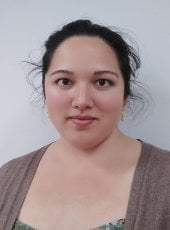Tiffany Lewis

Contact
- tiffanyl@mtu.edu
- 906-487-2658
- Fisher 124C
- Assistant Professor, Physics
- PhD, Physics, George Mason University
- MS, Applied & Engineering Physics, George Mason University
- BS, Physics, George Washington University
Biography
Dr. Lewis specializes in the study of theoretical astrophysics. Her analytic and computational methods tend to focus on understanding how subatomic particles gain and lose energy in the blazar jet environment. Thus, her expertise follows the physics expected in active galactic nuclei and astrophysical jets. Dr. Lewis also uses this expertise to consult on observations of active galaxies and the development of mission concepts for NASA.
Dr. Lewis also has a background in ground-based optical observing, having lead the George Mason University's research and outreach initiatives for 2 years, and coordinated exoplanet and active galaxy observations at Tel Aviv University's George B. Wise Observatory for over a year. She held a Zuckerman STEM Leadership Postdoctoral Scholarship jointly at Tel Aviv University and the University of Haifa's Center for Theoretical Physics and Astrophysics. Dr. Lewis also spent 3 years as a NASA Postdoctoral Program Fellow at Goddard Space Flight Center.
Dr. Lewis serves on the Steering Committee of the American Physical Society's Inclusion, Diversity, and Equity Alliance (APS-IDEA) where she is Chair of the Programming Committee.
Current Projects
Miss Jordan Forman, a post-baccalaureate fellow at NASA Goddard Space Flight Center, is working on theoretical model validation for a self-consistent, computational Fokker-Planck solution, including synchrotron self-Compton under the mentorship of Dr. Lewis. This code is appropriate for analyzing data from BL Lac-type blazars, which tend to be dominated by synchrotron self-Compton emission in their gamma-ray spectra. As such, she is working on an analysis of Mrk 421. In addition, we are collaborating with Dr. Janeth Valverde and Dr. Israel Castellanos Martinez on a similar analysis of another FermiLAT blazar as Miss Forman completes the multiwavelength reduction and observational analysis.
A leptohadronic model for flat spectrum radio quasars requires some parameter studies and then analysis of a few blazars to demonstrate its utility. It is not currently known whether flat spectrum radio quasars contain or significantly accelerate protons. Purely leptonic models tend to fit multiwavelength spectral data.
The Compton Spectrometer and Imager is a NASA Mission currently in development with a planned launch date in 2027. When it starts taking data, there need to be data analysis pipelines in place to reduce the raw data into science products like light curves and spectra, and to provide preliminary analysis. Those data pipelines are currently under construction within the collaboration, with opportunities to use Python and C++.
The Fermi Large Area Telescope collects data for over a thousand blazars. Each of those blazars can be analyzed using existing models to elucidate the jet physics that allows us to observe these astrophysical powerhouses. These analyses provide an opportunity to understand the most powerful sustained sources in the Universe.
Past Mentees
Dr. Pfesesani van Zyl, graduate career mentoring through the Fermi Collaboration; currently a Postdoctoral Researcher studying active galaxies at the South African Radio Astronomy Observatory.
Dr. Jenna Cann, undergraduate outreach and exoplanet research at the George Mason University Observatory; currently a NASA Postdoctoral Program Fellow studying active galaxies in the X-ray Lab at Goddard Space Flight Center.
Dr. Ryan Pfeifle, undergraduate outreach and exoplanet research at the George Mason University Observatory; currently a NASA Postdoctoral Program Fellow studying active galaxies in the X-ray Lab at Goddard Space Flight Center.
Specialties
- Active galactic Nuclei
- High-Energy Astrophysics
- Blazars
- Multimessenger Methods
- Theoretical Astrophysics
- Analytic & Semi-Analytic Methods
- Astrophysical Software